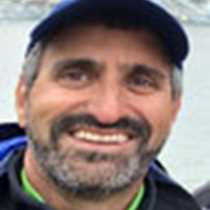In the Pack Ice and the Seven Islands
The National Geographic Explorer ventured deeper into the frozen floes of the Arctic Ocean, following leads in search of the iconic four-footed marine mammal. We squinted for suspicious creamy smudges of familiar shape in the icy seascape. We found gulls plucking on seal ribs, hovers of birds, and small assemblages of seals on large conglomerated floes, but the apex predator of the ice temporarily eluded us.
The pack ice evokes a soothing sensibility for the uninitiated as well as for the experienced. Crashing through improbable slabs of solid ocean in a monochrome vastness is not soon forgotten. The ocean off the map was of jigsaw floes, hummocked-up pressure ridges, turquoise pools, ice blink off the arctic skies and more. Harp seals, the ones born as bright-eyed too-cute white pups, periscoped out of the water and perched by breathing holes in the floes. Guillemots and gulls, fulmars and a few puffins feathered the scene.
National Geographic Photographer Kevin Schafer presented his photographic journeys In the Company of Animals and naturalist Geo-Jason Kelley gave us a Geologic Overview of Svalbard and Ice Forms. Jared Larson, one of America’s top science teachers and an on board National Geographic Grosvenor Fellow, carved a mark on the wooden window frame of the bridge for the polar bear he expertly spotted in the wastes of the Arctic pack ice.
The scene at the top of the world amongst ice and a sun-streaked ocean offered a relaxing way to contemplate our place on the map and in the world. After dinner we boarded Zodiacs to explore Phipps Island in the Sjuøyane group, seven sculpted islands at the top of Svalbard. Series of footprints streaked a snowy ridge to an obvious polar bear haunt. Walruses blew like little whales in the bay and piled up on the beach in a pile of leathery brown blubber with protruding pairs of tusked teeth.
In a rescue hut behind the beach we discovered a crate with a note offering a $100 reward for anyone delivering it to Svalbard’s capital Longyearbyen. From reading the hut’s journal we learned that the wooden box contained supplies from the ‘ARAT 2012 Expedition’ and that two men had recently traveled fifty-five days across the ice from the North Pole arriving at this hut where they rested two days before continuing on. We will deliver the crate on Sunday on our return to Longyearbyen.
As one guest commented today, “I like how the mood changes suddenly.” From the mesmerizing pack ice to walrus piles on desolate isles to the heroism of exploration, we discovered more of the Arctic today.




